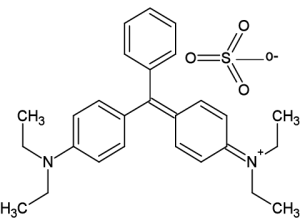What is the food additive E142 ?
E142 is a synthetic food additive belonging to the category of colorants, derived from coal tar. It gives a bright green color to aliments and is approved for use in various types of food. This food colorant is water-soluble but not soluble in acidic or alkaline solutions. As a food colorant, E142 , brilliant green, enhances the visual appeal of various food products.
The molecular formula for the food additive E142 is C27H25N2NaO7S2.

What is the recommended daily dose ?
The safety of food additive E142 has been evaluated by various health and food safety authorities. According to the European Food Safety Authority (EFSA), the maximum daily intake for E142 is 5 mg/kg body weight per day.
The approvals for the use of E142 vary by region:
- European Union: E142 is approved for use in certain categories of foods under regulated conditions.
- United States: E142 is not approved for use in food products in the USA.
- Australia and New Zealand: The colorant is permitted for use with restrictions on certain types of foods.
It is not allowed in foods intended for infants and young children.
Read also – World No Tabacco Day with the European InfoCons App
In which products is the food additive E142 found ?
Food additive E142, brilliant green, is used alone or in combination with other food colorants in a diverse range of products, such as:
- Alcoholic and non-alcoholic beverages
- Preserved fruit and vegetable products
- Fat-based desserts
- Cakes, biscuits, wafers, confectionery products
- Snacks
- Fish preparations and preserves
- Processed cheese
- Sauces, condiments, mustard
- Dietary preparations
- Dietary supplements
Beyond its use in the food industry, E142 is also used in pharmaceutical and cosmetic products, where it provides color to medicinal tablets, syrups, and creams.
Read also – E132 – INDIGOTIN (Indigo Carmine)
Contraindications and risks
The food additive E142, brilliant green, is generally considered safe for most people, but there have been reports of adverse reactions in some cases. These reactions include:
- Hyperactivity in children: Studies suggest a possible link between certain artificial colorants and hyperactivity in children, though more research is needed to establish a definitive connection.
- Toxicity: Some studies suggest that E142 could be toxic in high concentrations, potentially causing allergies, anemia, insomnia, and exacerbating asthma.
- Heavy metal traces: E142 may contain traces of heavy metals such as lead, copper, or arsenic, raising additional health concerns.
It is important for individuals with known sensitivity to food colorants to carefully check ingredient labels and limit their intake of foods with synthetic additives.
Read also – E141 – Copper complexes of chlorophylls
Limiting the amount of E142 in the diet
The safety of the food additive E142 remains a very debated topic. If you are concerned about consuming E142, you can:
- Check food labels and avoid products listing E142 as an ingredient.
- Opt for naturally colored foods whenever possible.
- Keep in mind that regulations regarding E142 vary by country.
Look for products with a cleaner label or those using natural additives.
By installing the InfoCons app and scanning food product barcodes, you can find out the number and types of food additives in the app.
Author – Cosmina Nițu
Master in Nutrition – Infant and new born nutrition
Sources:
www.efsa.europa.eu/ – European Food Safety Authority (EFSA)
https://www.researchgate.net/ – Research Gate